NATIVE PLANTS FOR NESTING BIRDS: TOP 12 PICKS
Derek Stoner, Project Coordinator for the Delaware Nature Society, helped restore the 860-acre Middle Run Natural Area by “intensive habitat management”, including planting 12,000 trees and shrubs. His lecture, “Native Plants for Nesting Birds: Connecting Flora and Fauna,” given to a group of enthusiasts at the Millersville Native Plant Conference in Pennsylvania, focused on his observations.
Derek’s landscaping recommendations for
attracting birds:
- Plant shrubs in clusters (“habitat circles”) that will create the dense cover that birds desire for nest protection.
- Locate clusters of bird-favored plants close to existing patches of habitat to allow for easier travel by birds.
- Plant taller shrub species in close proximity to low-growing bushes to create a layered effect that will host multiple bird species.
- Encourage “suckering” or basal shoots, as these tightly packed stems create ideal nesting pockets for birds.
- Dense clusters of stems are best for many birds to nest within, but some species need a more open branch structure to build their nests upon.
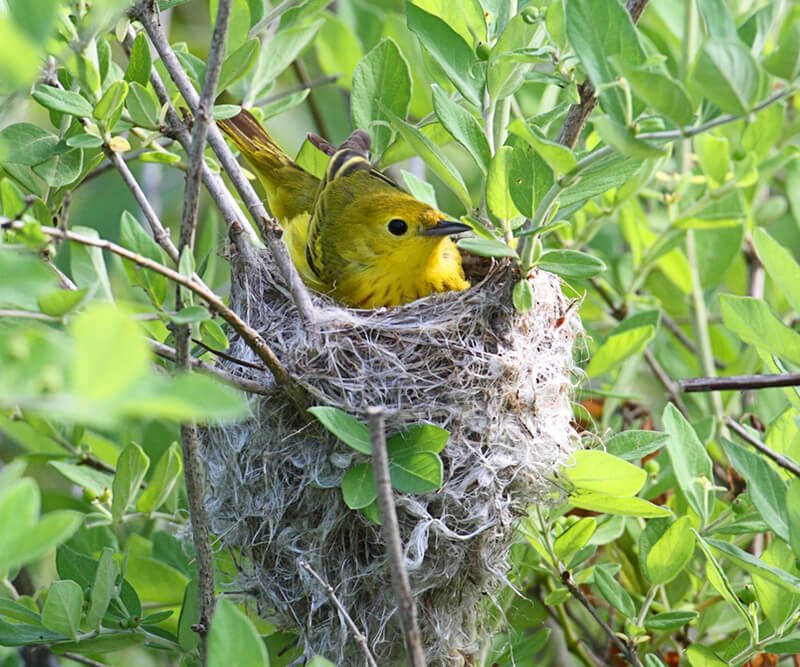
The shrubs and trees described below are found naturally growing in the Mid-Atlantic region and are Stoner’s top picks for attracting nesting birds. Plants were chosen for their appealing growth habit; their berry or fruit production, also noted, is an added bonus for birds. Just for fun, additional information is included on the number of Lepidoptera (butterfly and moth) caterpillar species each plant hosts (courtesy of Doug Tallamy’s research).
Derek’s top 12 plants for nesting birds:

Arrowwood viburnum (Viburnum dentatum).
Photo credit: Kent McFarland/flickr/CC.
1. Arrowwood viburnum (Viburnum dentatum). Arrowwood is an attractive, dense, easily grown multi-stemmed shrub. Soil, moisture and light adaptable, it can quickly reach 6 to 8 feet. Arrowwood spreads by suckering. The blue-black berries it produces are high in fat making them valuable to fall migrants. Numerous species of birds nest in this shrub including gray catbirds, towhees, mockingbirds, brown thrashers and cardinals. Viburnum species are also larval host plants for over 100 native butterfly and moth caterpillars.

Black chokeberry (Aronia melanocarpa). Photo credit: Kent McFarland/flickr/CC.
2. Chokeberries (Aronia spp.): Black chokeberry (A. melanocarpa) and red chokeberry (A. arbutifolia) are underused multi-season shrubs with excellent fall color. They prefer moist, acidic soils (pH <6.5) but are adaptable to drier sites. Black chokeberry is compact, generally 3 to 5 feet tall. Red chokeberry has an upright, narrow form, growing from 6 to 10 feet high. Both species can form large colonies and are best used in mass groupings or for a living hedge. They can also be planted for soil stabilization. Full sun is best for strong fruiting. In winter, birds eat the berries after more desirable fruit have been exhausted. Aronia species support five native Lepidoptera larvae.
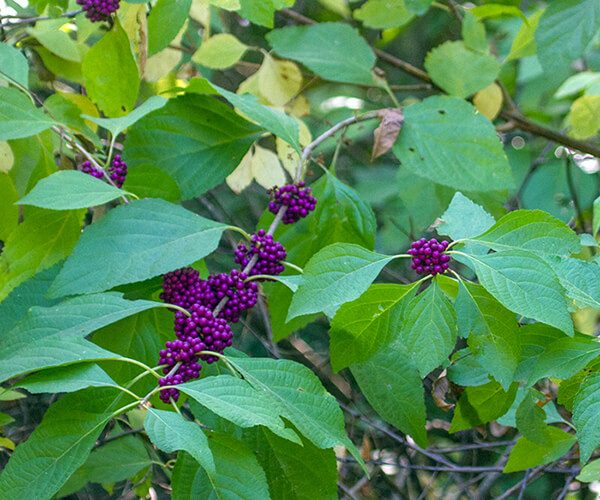
Beautyberry (Callicarpa americana).
Photo credit: Joseph Hood/flickr/CC
3. American beautyberry (Callicarpa americana). This pretty shrub prefers moist soils and part sun. It most often grows from 3 to 5 feet high and as wide with some shrubs peaking at about 12 feet. American beautyberry has long graceful arching branches and densely clustered fruit in late summer into fall. The small bright magenta berries are consumed by many types of birds.
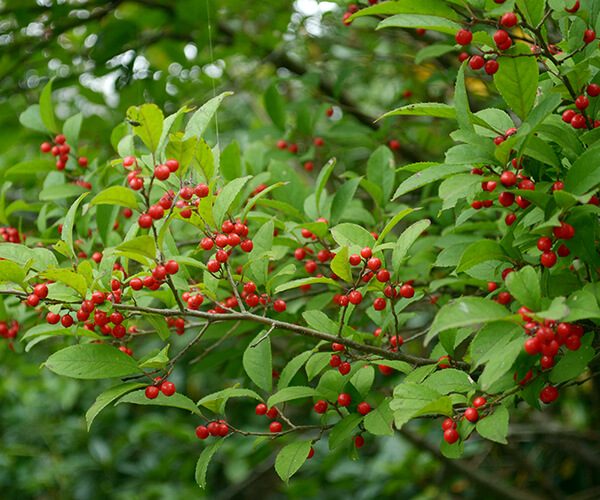
Common winterberry (Ilex verticillata). Photo credit:
Chesapeake Conservation Landscaping Council/flickr/CC.
4. Common winterberry (Ilex verticillata). The attractive winterberry has an upright form, usually 6 to 10 feet in height. A deciduous holly, it spreads by suckers to form large clumps. Winterberry grows in moist and dry conditions, preferring acidic soils and full to part sun. Like most plants of the holly family, it is dioecious (having separate male and female reproductive parts on separate plants). The female plant’s bright red berries adorn naked stems in winter, making winterberry desirable for landscaping. The berries also provide late-season fruits for birds. Ilex are larval hosts to more than 30 species of Lepidoptera.

Possumhaw (Ilex decidua). Photo credit: Jerome Collins/flickr/CC.
5. Possumhaw (Ilex decidua). A small understory tree or shrub, possumhaw can grow to 30 feet tall. It can usually be found in floodplain forests, swamps and other moist areas. Its intertwining branches are covered with tiny red berries in winter and are enjoyed by a whole host of wildlife. This Ilex is also dioecious, so male and female plants are needed to set fruit.

Inkberry (Ilex glabra). Photo credit: Elsa Spezia/flickr/CC.
6. Inkberry (Ilex glabra). This acid-loving evergreen shrub is denser when young, growing more open as it matures. Reaching anywhere from 4 to 12 feet in height, the species are generally dioecious (separate male and female plants) or monoecious (producing male and female reproductive structures on the same plant but on separate flowers). Birds frequent inkberry for nesting, cover and for sleeping. The flowers are attractive to pollinators and the black berries are a source of late-winter food for birds.
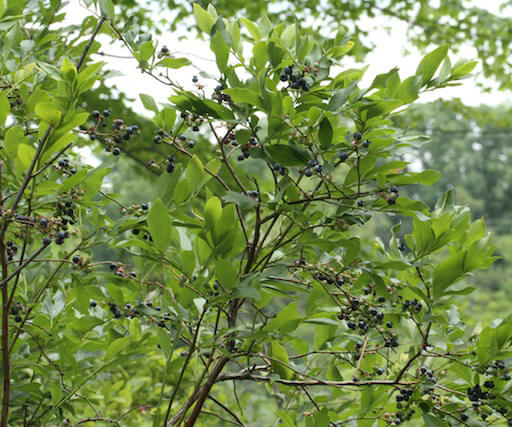
Highbush blueberry (Vaccinium corymbosum). Photo credit: Dan Nydick/flickr/CC.
7. Highbush blueberry (Vaccinium corymbosum). This Vaccinium is a multi-stemmed understory shrub with upright, spreading branches and spectacular fall color. It can reach 6 to 12 feet high and wide. Highbush blueberry’s preference is for moist, very acidic (pH 4.5 to 5.5), well-drained soil high in organic matter. Birds find this shrub appealing for nesting and for the delicious berries they produce in summer. In addition to supporting numerous birds and mammals, Vacciniums are the host plants to nearly 300 Lepidoptera species, helping them to earn the title of ‘high wildlife value’ plants.
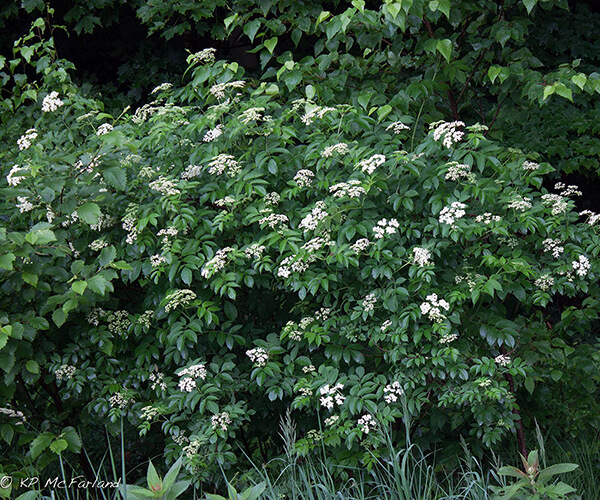
Common elderberry (Sambucus canadensis).
Photo credit: Kent McFarland/flickr/CC.
8. Elderberry (Sambucus spp.). Common elderberry (S. Canadensis) is a large shrub with arching stems, usually found in riparian areas but is adaptable to drier soils. It prefers full to part sun. Common elderberry grows to 12 feet tall and wide and continues to sucker, providing good nesting habitat. Clusters upon clusters of dark purple fruit are enjoyed by a wide variety of birds and mammals. Red elderberry (S. racemosa), in comparison, produces red berries, needs more moisture and prefers shady sites. It grows from 10 to 20 feet tall. Both species grow well in circumneutral soil (pH 6.8 – 7.2) and are short-lived. Elderberry is the host plant to over 40 Lepidoptera species. Sawfly caterpillars also enjoy the tender leaves and are a source of protein for baby birds.
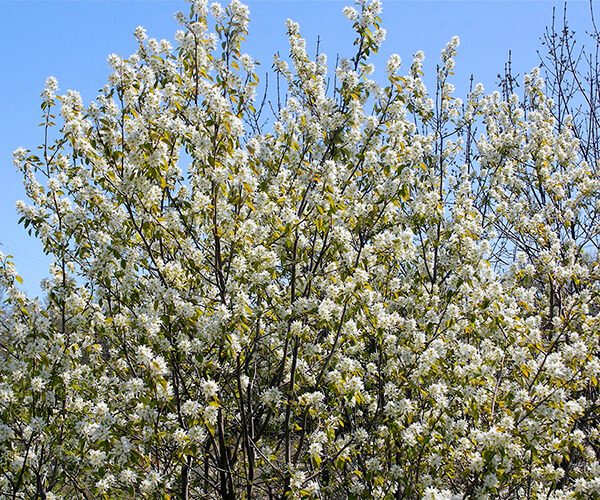
Common or downy serviceberry (Amelanchier arborea).
Photo credit: Dan Mullen/flickr/CC.
9. Serviceberry (Amelanchier spp.). Common or downy serviceberry (A. arborea) can grow to the height of 15 to 25 feet. It prefers moist, well-drained acidic soil but is adaptable to pH. Full sun to part shade is best. Canadian or shadblow serviceberry (A. canadensis) grows from 6 to 20 feet tall, has a shrubby, suckering habit, and wants more sun, moisture and acidity than A. arborea. Both the common and Canadian serviceberries, with their multi-branching habit, are excellent shrubs or small trees for nest sites and their berries ripen when nesting occurs, giving birds a convenient food source. Amelanchier species support over 100 Lepidoptera larvae.
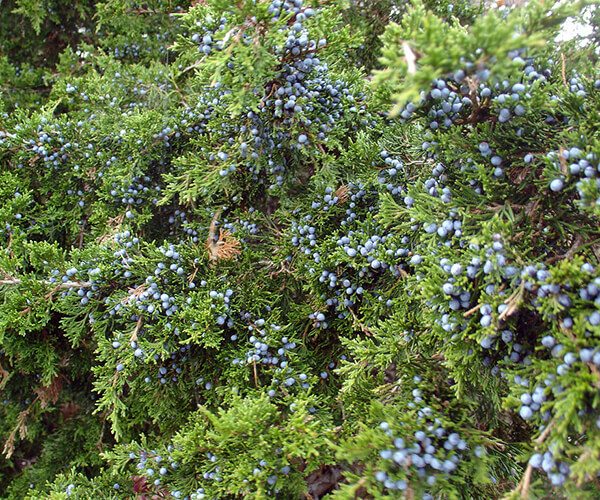
Eastern redcedar (Juniperus virginiana). Photo credit: Geneva Wirth/flickr/CC.
10. Eastern redcedar (Juniperus virginiana). Eastern redcedar is actually a juniper, not a cedar. A pioneer species found growing in open areas in full sun, this classic evergreen tree is usually 30 to 40 feet tall but can reach 60 to 90 feet. Drought hardy when established and adaptable to pH, redcedar prefers circumneutral soil (pH 6.8 – 7.2). Trees can be either dioecious or monoecious. Eastern redcedar provides excellent year-round cover, food, nesting sites and nest-building material for birds. It’s also the larval host plant for over 40 Lepidoptera species.
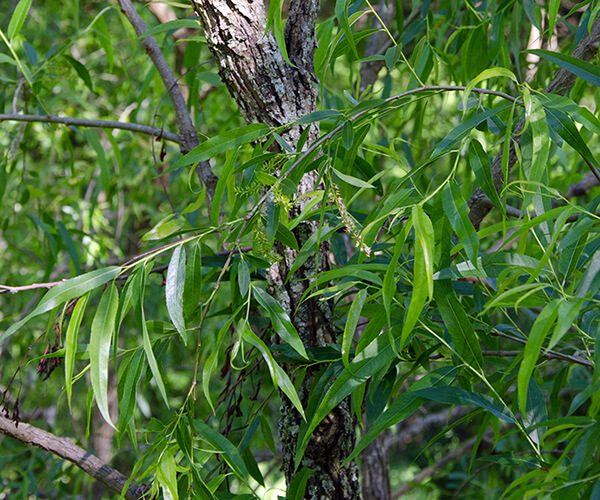
Black willow (Salix nigra). Photo credit: Suzanne Cadwell/flickr/CC.
11. Black willow (Salix nigra). Black willow is a rapid growing tree, maturing to 10 to 60 feet tall. It likes wet feet and naturally grows along streams. This willow prefers full to part sun, is adaptable to soil pH and has a dense, fibrous root system perfect for controlling erosion. The under-rated ‘witches broom’ branching habit invites numerous bird species to build their nests in them. Birds also make use of willow catkins and the soft downy fibers of seeds in constructing these nests. This tree is dioecious. Salix species host well over 400 species of Lepidoptera, making it a valuable plant for all wildlife. Black willow is short-lived, averaging about 65 years, but is an important environmental tree worthy of planting.
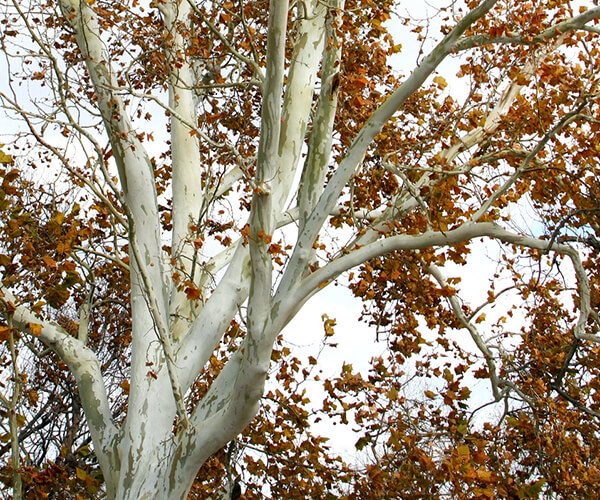
Sycamore (Platanus occidentalis). Photo credit: TexasEagle/flickr/CC.
12. American sycamore (Platanus occidentalis). Sycamore is a large open-crowned tree with enormous leaves and striking bright, mottled branches. It is found stream-side but can be grown in less moist sites. It tops out at 75 to 100 feet and 60 to 70 feet in width. Hummingbirds commonly build their nests near water in sycamores. Yellow-throated vireos, Baltimore orioles, robins and other species of birds will all nest simultaneously in this lovely tree. The American sycamore also hosts over 40 species of Lepidoptera.
There are many additional wildlife-friendly native shrubs and trees that nurture birds and other animals. As always, choose plant species that grow naturally in your area and prefer your growing conditions to reduce chemical inputs and resources, and to help keep our wild places healthy.
Many thanks to:
Derek Stoner of the Delaware Nature Society, check out the birding trail he created: Middle Run Birding Trail Brochure
University of Connecticut Plant Database
Ladybird Johnson Wildflower Center Native Plant Database
Update: November 28, 2015: The original photo of Callicarpa americana (#3) was actually the non-native species.
